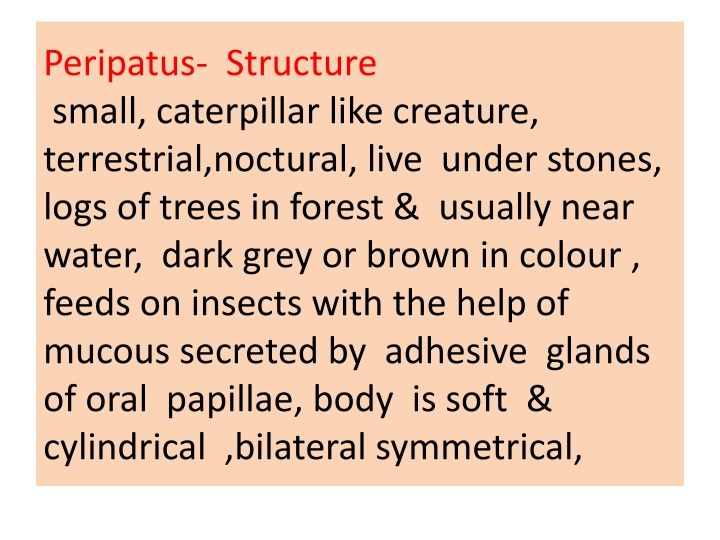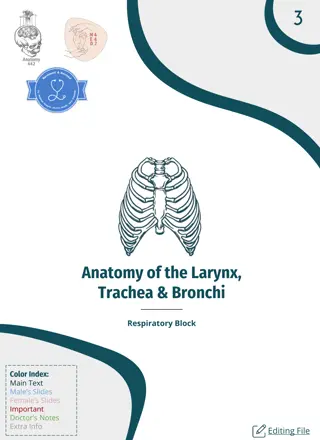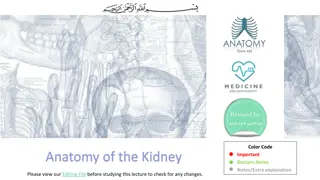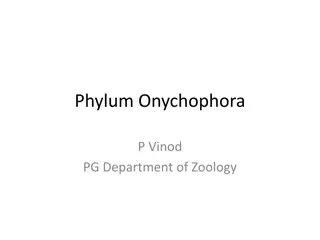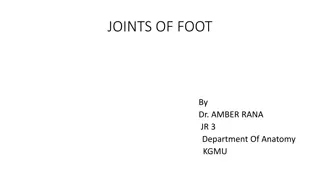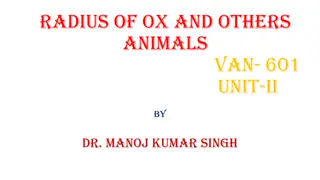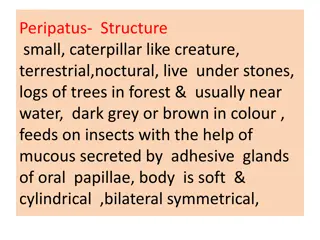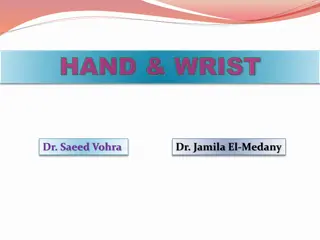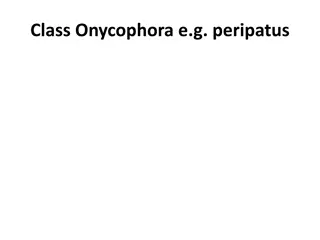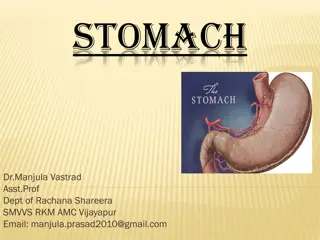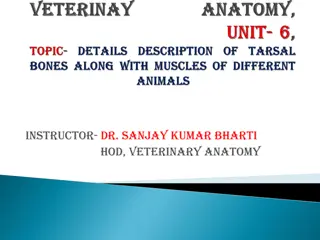Anatomy and Characteristics of Peripatus
Peripatus is a small, caterpillar-like terrestrial creature found in forests near water. It has dark grey or brown color, feeds on insects using mucous secreted by adhesive glands, and has a soft cylindrical body with bilateral symmetry. The body is divided into a head and trunk, with distinct features like antennae, mandibles, oral papillae, and walking legs with retractile feet for locomotion. Sensory functions are carried out by various appendages, and excretory pores are present on the ventral side.
Download Presentation

Please find below an Image/Link to download the presentation.
The content on the website is provided AS IS for your information and personal use only. It may not be sold, licensed, or shared on other websites without obtaining consent from the author.If you encounter any issues during the download, it is possible that the publisher has removed the file from their server.
You are allowed to download the files provided on this website for personal or commercial use, subject to the condition that they are used lawfully. All files are the property of their respective owners.
The content on the website is provided AS IS for your information and personal use only. It may not be sold, licensed, or shared on other websites without obtaining consent from the author.
E N D
Presentation Transcript
Peripatus- Structure small, caterpillar like creature, terrestrial,noctural, live under stones, logs of trees in forest & usually near water, dark grey or brown in colour , feeds on insects with the help of mucous secreted by adhesive glands of oral papillae, body is soft & cylindrical ,bilateral symmetrical,
indistinct segmentation, numerous superficial ring like annuli are present on the skin which give wrinkled nature to the body body is divided into Head & trunk Head : anterior part called prostomium, it bears a pair of eyes, a pair of antennae, a pair of mandibles & a pair of oral papillae
Antennae: representing Ist pair of appendages , provided with numerous spiny rings, also have tubericles provided with chitinous spines. Tactile in function and chief sense organs. Mandibles: 2ndpair of appendages, claw like chitinous jaws located deep inside the mouth, Each jaw is a small muscular structure having two sharp
cutting blades. A chitinous rod called apodeme is secreted from the base of mandibles to which muscles are attached. Salivary glands open behind the mandibles through salivary openings Oral papillae: 3rdpair of appendages, short, stumpy structures provided with tubericles, situated at the side of head. A slime gland opens at the
terminal end of each papilla. Sensory in function. Behind oral papilae mouth is situated on the ventral side. Roof of the anterior end of the mouth is thickened to form tongue covered with chitinous teeth Trunk: skin of trunk is thrown into wrinkles or annuli. Conical tubericles are present on the skin. It bears 14- 43 pairs of segmentally arranged
appendages called walking legs. Each leg is hollow and cone shaped and provided with tubericles arranged in rings. At the tip of leg ,there is a retractile foot provided with claws . Below the foot the leg has some spiny pads to provide grip to the animal during locomotion. Excretory pores are present on the ventral side of walking legs .
Coxal glands also open at the base of leg. Anus is at the posterior end of the last segment. Body is covered with chitinuous cuticle. Body cavity is haemocoel. True coelom is restricted to cavities of gonads and excretory organs. Alimentary canal is a straight tube
Respiration is carried by tracheal system. Spiricles are distributed all over the body. Heart is tubular and enclosed in a pericardial sinus Excretion by nephridia which are segmentally arranged in pairs Sexes are separate, in males seminal vesicles are present in front of vas deferens.
Fertilization is internal. Most of the species are viviparous. Affinities: Peripatus has been existance since the cambrian period without any change in the animal i.e. Living fossil, exhibits diocontinuous distribution
History: first discovered by Guilding in 1825. He thought it was to be a Mollusc because of its soft body and sluggish movement. Mosley in 1874 observed the tracheal system and considered them as Arthropods. Peripatus has both Annelidan as well as Arthropodan characters besides some special characters, So Onychophora has been described as
missing link between the two phyla. Earlier this phylum was considered as subphylum in Arthropoda. But now it is treated as a separate phylum .
Annelidan characters: 1. Body is worm like 2. External segmentation does not correspond with the internal segmentation of the body as in Hirudinia 3.Homonomous type of segmentation is present in both phyla,it means all segments are alike 4. Body wall is dermo-muscularin both phyla
5. Cuticle is thin and flexible secreted by epidermis. It is not in the form of plates which show articulation as in arthropoda. 6. Legs of peripatus resemble that of parapodia of annelida in their structure. They are hallow,stumpy and unjointed structures. 7. True head is absent
8. Presence of paired nephridia in almost every segment of the body 9. Eyes are simple 10. Muscles of the body are unstriated type. 11. Slime glands and coxal glands correspond to similar type of glands of Chaetopoda 12. Reproductive tracts are ciliated
Arthropodan characters: 1. Body is like that of a caterpillar 2. The cuticle is chitinous 3. appendages are provided with claws like Chilopods 4.Presence of one pair of antennae which are jointed 5.Presence of one pair of mandibles which are provided with striped muscles
6. Locomotion is with the help of legs which have muscles & claws. 7. Body cavity is haemocoel. Blood is colourless as in arthropods 8. Coelom is limited to nephridia and gonoducts 9. Jaws are modified appendages 10. Dorsal tubular heart enclosed in pericardial sinus
11. Respiration by tracheal tubes 12. Presence of salivary glands 13. Presence of coxal glands as in arthropods 14. Brain is typical arthropodan type 15. Development is similar to that of arthropods.
Differences with arthropods: 1.Trachea are not arranged like that of arthropods. In many Onychophores each segment has many permanently opened spiracles 2. Formation of skin is not like that of arthropods 3. two ventral nerve cords are widely separated from each other and also connected woth each other by
transverse commissures unlike arthropods 4. structure of eye is less complicated Relation with Mollusca: 1. Body is soft like that of a snail 2.ladder like nervous system resembles that of Chiton because of these resemblances Onychophora included under mollusca in the early days
Special characters: 1. body is thrown into wrinkles but not externally segmented.some considered these wrinkles as annuli. 2. though cephalisation is not clear, the head can be differentiated and so cephalisation is in mid way between annelids & arthropods 3. movement of jaws is in antero- posterior direction which is not seen in other groups
4. Skin of Onychophora is velvety and is provided with a number of tubericles. 5. Though tracheal respiration ispresent the spiracles are irregularly distributed on the body surface 6.two ventral nerve cords are widely separated without ganglia.
They are connected with trasverse commisures and resemble that of Platyhelminthes 7. Eyes are not as complicated as that of arthropods 8. in Peripatus testes open into vas efferentia. They open into seminal vesicle which lead to vas deferentia .It is a unique feature. 9. Most of them are viviparous
The Onychophores have both annelidan and arthropodan characters and also some unique characters. They can neither be included in Annelida nor included in Arthropoda. The common features of Onychophora with annelids and arthropods do not have any phylogenetic importance. Hence Onychophora has been given a separate phylum status along with Annelida & Arthropoda.
